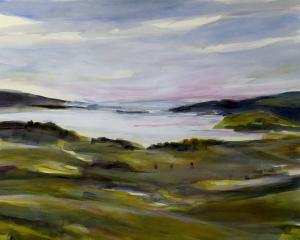The 2009 Print Fair, various artists (Gallery de Novo)Chanelle Carrick looks at the latest exhibitions in Dunedin.
Gallery de Novo's annual print fair features more than 20 artists working in a range of printmaking techniques.
Philip Beadle uses drypoint, a process by which an image is incised on to a plate, allowing a more fluid, sketchy approach to printmaking.
In The Octagon Beadle uses the medium to its full advantage by employing loose and gestural marks, creating a real sense of the blustery wind and rain as figures with umbrellas seek cover.
Drypoint also allows for highly delicate and precise mark-making, however, as seen in Kyla Cresswell's Inhabitant #4.
In this diptych, fragile green tendrils and leaves appear as though pressed under glass, their arabesque-like curves standing out crisply against a stark white background.
Unlike the intaglio processes of Beadle and Cresswell, lino and woodcuts are often used to create more linear, solid effects.
Made from a lino cut, Rob Piggott's Footbridge, for example, is a striking image, the strong black crosshatching forming not only a sense of solidity but also dissolving the image into an almost abstract geometric pattern standing out against a rose-coloured backdrop.
In Taniwha Jono Moore uses the strong lines of the woodcut to build up a range of textures.
The strongly outlined leaves and trunk of cabbage trees contrast with the almost decorative curvilinear designs of Maori rock drawings.
The Unguarded Moment, James Dignan (Temple Gallery)
James Dignan's latest exhibition focuses solely on portraiture, with paintings from 2003 to 2009.
Working in a photo-expressionist style, Dignan digitally alters photographs through tonal separation and uses these as the basis for his portraits.
With some works this alteration takes physical representation to the extreme.
In Cynthia Mask, for example, the contours of the face have been reduced to a solid maroon silhouette on a glowing orange background, creating an almost surreal depiction not of a specific individual but of an abstracted form.
The intimate, close-up format of Dignan's portraits would suggest a personal relationship between the artist and sitter.
Many of the subjects of his works are, however, drawn from the internet.
His close scrutiny can, therefore, be considered a desire to focus the viewer's attention, drawing them in to establish their own relationships with each individual.
These relationships too, vary, in the way the viewer is invited to interact with each face.
Some, like the woman from Rosanna Knows, stare directly out with an intense, almost accusatory glare.
Others, such as the title work The Unguarded Moment depicts a moment of personal contemplation, the young woman's inward gaze making her potentially vulnerable.
The shared format, however, gives these works a sense of connection, as if each individual is part of a larger unified narrative.
As such, when standing amid their stares, some confident and confrontational, others private, the viewer almost becomes the subject of their own unguarded moment.
Glenn Gould - Themes and Variations, Barry Cleavin (Brett McDowell Gallery)
This series of etchings and aquatints depicts Glenn Gould, a celebrated pianist of the 20th century.
Cleavin repeatedly depicts Gould at the piano, further linking the works to musical expression with the use of titles such as Fugue 1, Gavotte and Allemande.
Other works, such as The Interview 2 or Still Life 2, do not depict Gould.
Instead they seem to be part of a broader narrative, breaking up the reiteration of the exhibition to perhaps allude to a particular episode in the pianist's life.
In the repetition of form, however, can be seen a reference to the obsessive, rhythmic processes of a musician's mind.
Cleavin breaks each image down into monochromatic negatives and positives, mostly in cyanotype blue.
As a result several of these works appear almost abstract when seen close up, reduced to near-incomprehensible patches and overlays of colour which seem to float above the white surface of the paper.
Prelude and Fugue, however, present two depictions of Gould, one in blue and the other in red.
This striking contrast of colour, paired with the musical terms, creates a sense of progress, of a beginning and an end.
With these works Cleavin seems to suggest a sort of dialogue between the art of the musician and that of the printmaker or artist.



!["Flux" featuring Portraits of Geoff Dixon (2021–2025), acrylic on paper [installation view], by...](https://www.odt.co.nz/sites/default/files/styles/odt_landscape_small_related_stories/public/story/2025/07/1_macleod.jpg?itok=ywgJww50)








